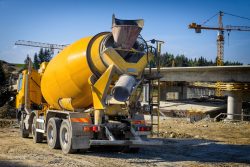Hours vs. Miles – What’s Better for Determining Maintenance Schedules
Why Significant Wear During Vehicles with Extended Idle Time Often Favors Using Hours
The debate of how to calculate maintenance schedules for trucks used in various applications has existed for many years, with operators often using whatever method they’ve traditionally relied on. According to our SCL experts though, depending on the needs of your fleet, it could be time for a new calculation.
Although using miles may be appropriate for long-haul trucks with little stop-and-go, for those that have significant daily amounts of idle time, hours offers a much more accurate picture of what’s happening with an engine.
“Depending on the application of the vehicles, maintenance intervals may vary,” states Ford Power Stroke Diesel. “Some of the more common applications of Super Duty Trucks and Econoline Vans require the engines to idle extensively. With these applications, it is important to understand how idling impacts certain regular maintenance intervals.”
WHEN MILES CAN WORK
If you’ve been using miles to calculate your maintenance schedules, here’s some good news: trucks with mostly highway miles are most likely accurately maintained if that’s your preferred method.
It’s also a good way to determine true value when buying or selling a truck from your fleet. “A truck that’s over-the-road long hauling doesn’t idle as much as other medium-duty trucks like waste haulers or construction vehicles,” said SCL General Manager Travis Becktel. “In vehicles with long periods of idle time, you have to convert those engine miles to hours for an accurate picture.”
Many aftermarket buyers evaluate their trucks based on a multiple of 35; SCL uses a multiple of 25. For example, for every 10,000 hours of run time in vehicles with high idle times, it equates to 35 times that in miles.
For mixed fleets, it gets a little more complicated, Brian Tabel, director of marketing for Isuzu Commercial Truck of America, Inc. (ICTA) told Worktruckonline.com. “Both hours and miles are important criteria when determining service timing for a fleet,” he said. “Any systems that directly interface with the engine (fuel, cooling, exhaust, etc.) would be strongly impacted by the engine hours.”
WHY HOURS ARE OFTEN FAR MORE RELIABLE INDICATORS
Most heavy-duty off road and medium-duty truck applications undergo much more consistent periods of idling, or operating at lower speeds, than passenger vehicles or over-the-road trucks. Think waste management trucks, liquid pumping trucks, cement mixers – their engines are working far more even when the odometer readings don’t change much.
According to Ford, with the 6.0L Power Stroke Diesel, for example, while idling, engine oil is repeatedly compressed to levels above 3,000 pounds per square inch (psi) in order to achieve desired fuel pressure. That means “at idle, the oil becomes fatigued although the vehicle’s odometer reading remains unchanged,” making maintenance intervals based only on miles driven inadequate.
“As an engine idles, the wear to consume one gallon of fuel is equal to driving up to 30 miles,” said Joe Korn, a senior analyst for ARI. “In these situations, it is more effective to schedule future vehicle replacements or measure life-cycle costs based on the hours of engine operation or the amount of fuel burned over a period of time.”
“We want our customers to understand that they need to look at their fleet as a whole, which sometimes merits using different calculations depending on what equipment you have,” Becktel said. “You can’t determine a true value or the needs of your fleet overall if you’re only looking at it from one point of view. That’s why fleet evaluations are so important in determining a comprehensive preventative maintenance plan, which truly ends up saving you time and money in the long run.”
WHY THE RIGHT CALCULATION CAN SAVE MONEY + TIME
Having a more accurate picture of when your specific vehicles in your fleet need service saves on downtime; it lowers your risk of catastrophic repairs that put vehicles out of service for weeks rather than hours for maintenance; and it saves money on fuel economy when you choose products that best fit your vehicles’ applications
There’s also a benefit on the back end.
Like 18 other states, California has a program to provide incentivizes for vehicles that track productive idling vs. non-productive idling time. The Motor Fuel Tax Refund for Off-Road Use allows businesses and owners to secure a tax break on fuel used to power vehicles and equipment used off-road.
Each state has its own forms and rules for applying for a state motor fuel tax refund. In California, cement mixers, concrete pumpers or similar vehicles often rely on Power Take Off (PTO) units to turn mixers and pump cement, which still burns fuel but in an “off road” application. Providing documentation of those instances allows companies to apply for the tax break either at the end of the year; companies may also choose to apply for partial exemption up front to receive compensation.
To determine the best solutions for your fleet – whether that’s creating an optimal preventative maintenance plan or exploring new products, contact your SCL representative.
Contact an SCL Consultant today
In a wide range of automotive, industrial and commercial sectors, SCL remains steadfast on its commitment to product and industry knowledge, performance satisfaction and superior logistics. We protect and optimize the machines that keep our country moving. For more information on how we help can help with services including bulk purchasing or managing inventory, contact an SCL expert today.

